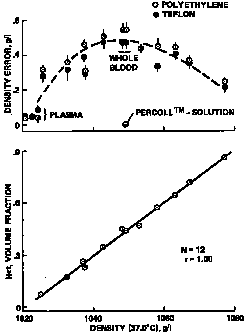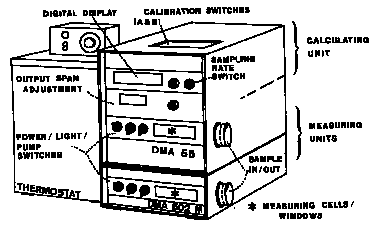 "Density error":
Difference between meanąSD readings using a DMA-602 (lower device0.1
ml sample volume) and DMA-55 (upper device2.0 ml sample volume) when
using whole blood or red cell concentrate (note: no "error" when using
blood-isodensic Percoll-solution).
"Density error":
Difference between meanąSD readings using a DMA-602 (lower device0.1
ml sample volume) and DMA-55 (upper device2.0 ml sample volume) when
using whole blood or red cell concentrate (note: no "error" when using
blood-isodensic Percoll-solution).
Background & method: This publication investigates the reliability of the mechanical oscillator technique (MOT) for blood and plasma mass density measurements on small samples, points to possible methodical pitfalls, and shows how the process of sampling and preparation and certain measuring conditions may influence the resulting data. Densitometers of different size were used to evaluate rheological influences on blood density (BD) readings.

Results: Measurements on fractions from identical samples and repeated samplings from test subjects under steady-state conditions revealed a 0.01 g/l reproducibility of density readings if plasma-isodensic heparin solution and siliconized densitometers are used. The mean plasma density (PD) readings did not change significantly after up to 1-wk storage at +4 deg C or up to 2 mo storage at -20 deg C. The variability of the PD findings increased with storage time and were generally higher with storage at -20 deg C, compared with +4 deg C. Best reproducibility of plasma density values was obtained when samples were kept at 4 deg C. The accuracy of microsample (0.1-ml) discontinuous blood density measurements may be biased (up to +0.5g/l) by rheological phenomena occurring during the sampling and filling procedures. The amount of the according blood density increase depends on the sample's hematocrit, with most pronounced effects in the normal hematocrit range (see figure). Linear correlations between PD and plasma protein concentration, between BD and blood hemoglobin concentration, and between erythrocyte density and mean corpuscular hemoglobin concentration were highly significant.
Conclusion: Rapid density measurements with up to 0.01 g/l reliability on small (<0.1 ml) volumes of biological fluids and continuous blood densitometry can be performed with use of the MOT.
Practical considerations: Sources of measurement errors that can reduce both the accuracy and precision of density determinations include storage of plasma samples, inhomogeneity of blood samples, and density reading before adequate temperature equilibration. Plasma density correlates to plasma protein concentration, blood density to blood hemoglobin concentration, and erythrocyte density to MCHC in a linear fashion. The reliability of the density measurements is better than that of plasma protein, hemoglobin, and hematocrit methods.
![]() >> Homepage
>> Homepage